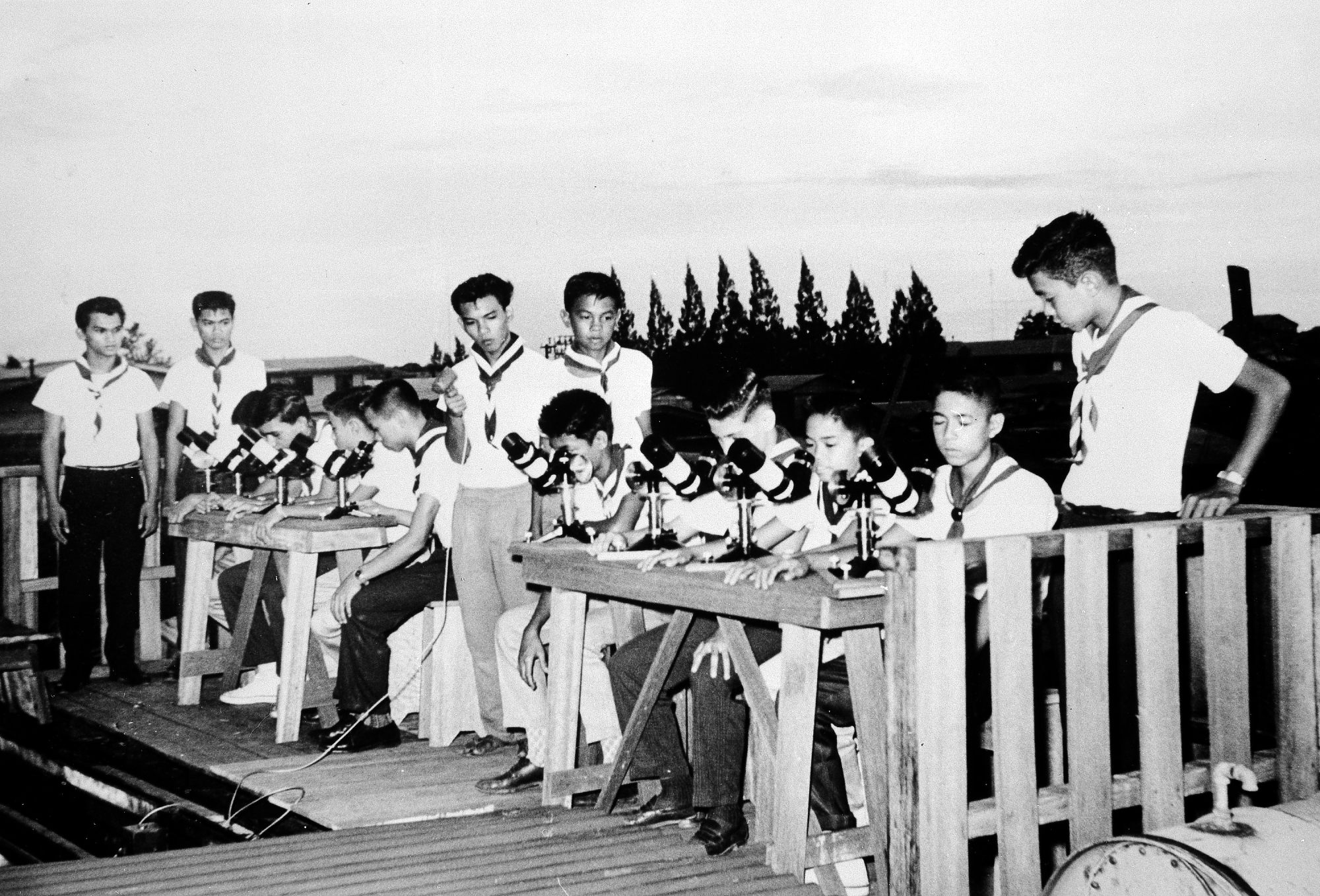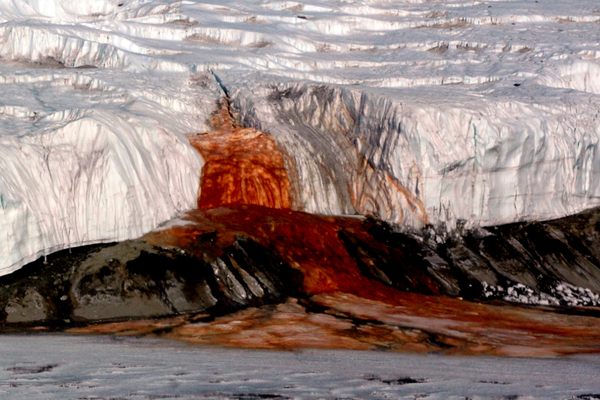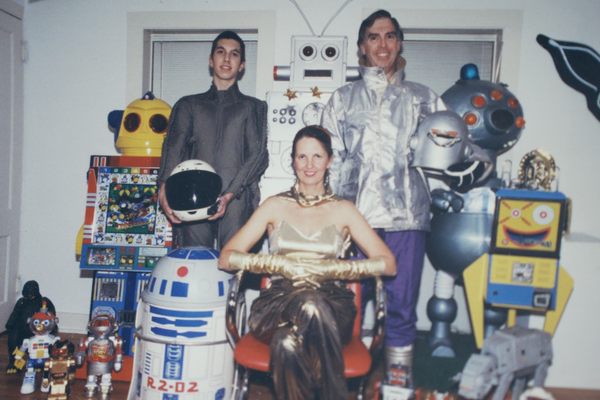Amateur Astronomers Have Always Been Great at Finding Satellites
A bunch of teens at picnic tables were the first people to track Sputnik I.

Last week, an amateur astronomer named Scott Tilley made headlines after finding a NASA satellite that had been lost for over a decade. The IMAGE satellite, which was meant to study the magnetosphere, was launched in 2000, and lost contact with Earth back in 2005. Tilley, who uses radio equipment to track objects whose orbits are undisclosed, rediscovered it on January 20, while looking for something completely different.
By finding IMAGE, Tilley has returned an important instrument to NASA’s interstellar toolbox. But he’s also added himself to a long-standing pantheon. Ever since the first satellites were launched, amateur astronomers have played a vital role in keeping tabs on them. In fact, when the Soviet satellite Sputnik I took the United States by surprise in October of 1957, legions of practiced volunteers were ready to track it, armed only with enthusiasm, low-power telescopes, and a good sense of timing.
These volunteers were part of Operation Moonwatch, a massive citizen science project started by Fred Whipple, then the director of the Smithsonian Astrophysical Observatory in Cambridge, Massachusetts. Whipple dreamed up the project to coincide with the 1957-1958 International Geophysical Year (IGY), during which scientists around the globe worked with and against each other to learn more about how our planet is composed. As part of the IGY, the United States and the Soviet Union both planned to launch the world’s first artificial satellites.


The launch was only about half the problem, though. Once the satellites were up there, scientists would have to find them again—a difficult proposition. The Astrophysical Observatory was already at work on a series of instruments, called Baker-Nunn cameras, that would be able to follow and photograph objects in orbit, but first, someone had to figure out where to point them. As the radio astronomer John P. Hagen put it to the Los Angeles Times in 1956, “Suppose some joker flies a plane up to 60,000 feet and throws out a golf ball… Can you find the golf ball? That’s about the task in locating the satellite.”
But Whipple had an idea. “From the start, Whipple planned that the professionally manned Baker-Nunn stations would be complemented by teams of dedicated amateurs,” W. Patrick McCray writes in his history of Operation Moonwatch. These amateurs would intercept and track the satellites’ paths through space, reporting exactly where in the sky they showed up, and when. After that, as The New York Times explained, “A giant computer, or ‘electronic brain,’ at Cambridge will digest the information and predict where the satellite can be seen again at any time for the next year or so,” allowing camera stations to get ahead of the satellites and do their work.
Whipple knew from the beginning that such a project would require large groups of volunteers, and that many of them would be young people. In late 1956, he placed an article in The Saturday Review soliciting participants. The satellite launches of the IGY would include “thousands of men and women of all hues, creeds and ideas,” he wrote. They would be contributing to a task so new, it didn’t even have a name. (He suggested “PLORB,” because it involved “placing” artificial moons in “orbit,” but this did not quite catch on.)

Whipple brought on a couple of recruiters, settled on the better name of “Moonwatch,” and began building up teams of volunteers in locations across the U.S. Groups eventually formed in other countries as well, including South Africa and Peru.
Generally, the setup worked like this: Teams brought out a bunch of low-power telescopes, which they’d either built themselves or bought for about $50 each. Each of these telescopes pointed down at a small mirror, arranged to reflect the sky above, so that viewers could watch the heavens for hours without craning their necks. The Moonwatchers lined up at a prescribed latitude and longitude, and arranged their telescopes so that the fields of view overlapped slightly.
“We’d go out there after sunset, and we would get ready to go,” recalls Gil Moore, an Operation Moonwatch participant who went on to lead another youth-directed, satellite-focused citizen science program, Project Starshine. “We’d look down into the mirror, and we’d have this line across the heavens in our minds. We’d know the constellations and the stars.”

When the satellite came zooming into each participant’s field of view, they’d let the others know they had seen it: for instance, by saying a set of commands—Moore remembers saying “Able” when it entered, and “Mark” when it reached the center—or pressing a special button that let out a beep. As the satellite continued on its way, “the next guy or gal would go,” Moore says, on down the line. A group member recorded the times and places of interception, and they were then called or radioed into the central lab and entered into the computer. By combining these readings from groups across the world, the satellite’s trajectory could be plotted.
Many of the teams were offshoots of existing amateur astronomy groups, which made the best of the limited resources they had. Jim Cook, a high schooler at the time, remembers his first night with the Moonwatch team in Cambridge. “‘Operation Moonwatch, located at Harvard Observatory’—that was a real classy name,” he says. “I was surprised to find that their work was conducted on the roof of the library, and that they met in the stairway leading up to the roof.”
Similarly, the teams practiced any way they could, McCray writes. They would toss pebbles into the air, track moths that happened by, and participate in the occasional national test, run by the Civil Air Patrol. Sometimes, they would just use their imaginations, “pretending we saw a satellite cross our telescope’s field of view, and shouting the proper responses so they would be recorded on the tape with the time signals,” says Michael Seeds, who participated in Moonwatch through the Danville Astronomical Society, in Illinois.

All this was meant to prepare the teams for their first official task: to track satellites launched by the United States, which were to be sprinkled through the sky beginning in early 1958. Most Moonwatchers took it as a given that these would be the first satellites overall. In the fall of 1957, during a practice session, Danville team leader David Morrison “shouted at us to shut up and concentrate, because ‘The Russians might have put up a satellite.’” Seeds remembers. “We laughed at him.”
But then, on October 4, 1957, Sputnik I took off from Tyuratam and entered low Earth orbit. The small satellite “shocked the heck out of the U.S.,” as Moore says. The Baker-Nunn cameras weren’t even ready yet.
Operation Moonwatch was, though. As soon as Sputnik’s launch was announced, the volunteers hurried into action. On October 8, a team in Australia was the first to spot the satellite, going west to east at about 18,000 miles per hour. Two days later, a group in New Haven, Connecticut, made the first sighting over the U.S. Until all of the cameras were ready, it was Moonwatch teams who bore the brunt of keeping tabs on Sputnik. “Rather than supplementing the professionally manned stations… amateur teams quickly became an essential stopgap, fulfilling a task the [SAO] never intended for them,” McCray writes.

All of this was hard, cold work. “Through the winter after Sputnik we observed many evenings and before dawn, and it was freezing to sit at your scope and not move for what seemed like hours,” says Seeds. When he thinks about Moonwatch now, he can still smell the lighter fluid from the portable handwarmer he brought with him to observation sessions.
Operation Moonwatch kept going for another 18 years, during which time the group helped to track dozens of man-made orbiters. Moore remembers being the first on his team to spot one of the U.S.’s Vanguard satellites. When Sputnik IV crash-landed in the United States, Moonwatch teams helped pinpoint where its debris ended up.
Perhaps most importantly, though, the group proved that amateurs could play a vital role in the astronomical sciences. “THEY said it couldn’t be done! THEY said it couldn’t work!” Whipple wrote to former Moonwatchers in 1975, when the program was finally dissolved. “THEY were dead wrong!”

This isn’t to say there weren’t some mishaps. Cook recalls one time, when his team lost track of Sputnik II—the satellite that held Laika, the first dog in space—and decided to further crowdsource their efforts. “We put it out to the public that we had lost a satellite, and if anybody saw it, please call,” he says.
They quickly heard from a local woman who said she had spotted the satellite. She gave them plenty of helpful information, including the latitude and longitude of her house, and exactly what stars the object had passed by, and when. And then, she blew it, Cook says: “She said she knew the dog was okay, because she could see it with her binoculars, and its tail was wagging.”
Cook and his team were ready to discount all of her observations. “But lo and behold, the stuff she gave us, it was right!” he says. “We found the satellite the very next observing session.” And so the devoted volunteers of Operation Moonwatch kept on going, doing their best with what they had each step along the way.


















Follow us on Twitter to get the latest on the world's hidden wonders.
Like us on Facebook to get the latest on the world's hidden wonders.
Follow us on Twitter Like us on Facebook